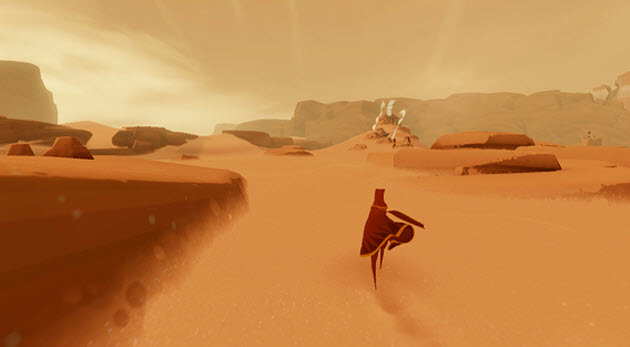
At the beginning of the game, you play a robed character walking around in the sand. A sweet melody plays, but there are no words. No narration. Nothing tells you what to do. You just push your analog stick on the controller forward and your character starts moving through the sand.
AI Weekly
The must-read newsletter for AI and Big Data industry written by Khari Johnson, Kyle Wiggers, and Seth Colaner.
Included with VentureBeat Insider and VentureBeat VIP memberships.
“We look at games and how they can produce more primal emotions,” Chen said. “But most games are just about competition or violence.”
In Flower, Thatgamecompany managed to pull off a story with a nonviolent theme. You play the wind in the dream of a flower in the middle of a dying city. I still remember how beautiful the colors were in that game and how beautifully rendered the grass was as the wind blew through it.
With Journey, the sand gives me that same reaction. The sand is a graphics marvel. It moves and looks and behaves physically as you expect sand would. It makes a sound when you walk through it, and it brings a smile to your face. In short, walking through sand in this game is fun.
It’s very unusual for a company to spend so much time getting something like sand right. Thatgamecompany was founded in 2006 by Chen, creative director, and Kellee Santiago, president. Both of them were graduate students at the University of Southern California’s School of Cinematic Arts, Interactive Media Program, when they started making games. Their first experiments, Cloud and Flow, were unique creations. The company gathered steam when Sony published Flow on the PlayStation Network in 2007 and then Flower in 2009. It has just a dozen employees.
Robin Hunicke, producer of the Journey game, said in a recent talk that while AAA games may be all about violence, her company wants to make EEE games, where the E stands for “elegant,” “expressive,” and “emotional.”
Chen added, “We want to explore games in different areas of the emotional spectrum. We knew this game would be on the PlayStation Network, so we wanted to have you explore unique emotions and apply them in the online space. You can experience this game and play it together with people in a connected environment.”
[aditude-amp id="medium1" targeting='{"env":"staging","page_type":"article","post_id":297259,"post_type":"story","post_chan":"none","tags":null,"ai":false,"category":"none","all_categories":"business,games,","session":"A"}']
Chen said that the inspiration for Journey had to do with creating something that was the opposite of what you can usually do in a game.
“You can do things like drive fast cars or get information at your fingertips in today’s society. In our games, we can do the same kinds of things. When you play multiplayer games, you are generally trying to get the best individual statistics. What if we remove that and give you a new multiplayer online experience that connects you?” Chen said.
[aditude-amp id="medium2" targeting='{"env":"staging","page_type":"article","post_id":297259,"post_type":"story","post_chan":"none","tags":null,"ai":false,"category":"none","all_categories":"business,games,","session":"A"}']
So what is Journey all about? Hunicke explains her approach to the game as an attempt “to remove those obstacles between two people on a journey.” I didn’t really know what he was talking about until I played more of the game. I walked from one spot in the desert to another. The game showed me silently how to tilt the controller so that I could shift the point of view. I visited a ruin, There were some strange markings on it. I walked over to spots where I could see little kites or flags flying around in circles. I walked up to them and they gave me the energy to jump into the air and fly.
I looked out in the landscape and figured that the point of the game was to walk from one set of flags to another. When you collect flags at one point, you can extend a magic carpet that takes you up to the top of a ruined stone building. Then you keep collecting flags until you extend that magic carpet all the way to your destination. Once you are there, you meet a mysterious character, sort of like a big nun, who communicates to you in a different language. From there, you move on to the next part of the journey.
I see how you can play it with someone else. You can collect flags together and get the tasks done more quickly, allowing you to progress through the game faster. There is no standard multiplayer feature such as statistics that log how many points you have. Always, in the distance, you can see the mountain looming before you, getting bigger. It makes you feel small.
I have no doubt that Journey will be a unique experience. But with so little action, the game developers will have to make sure the experience never becomes boring.
[aditude-amp id="medium3" targeting='{"env":"staging","page_type":"article","post_id":297259,"post_type":"story","post_chan":"none","tags":null,"ai":false,"category":"none","all_categories":"business,games,","session":"A"}']
VentureBeat's mission is to be a digital town square for technical decision-makers to gain knowledge about transformative enterprise technology and transact. Learn More
